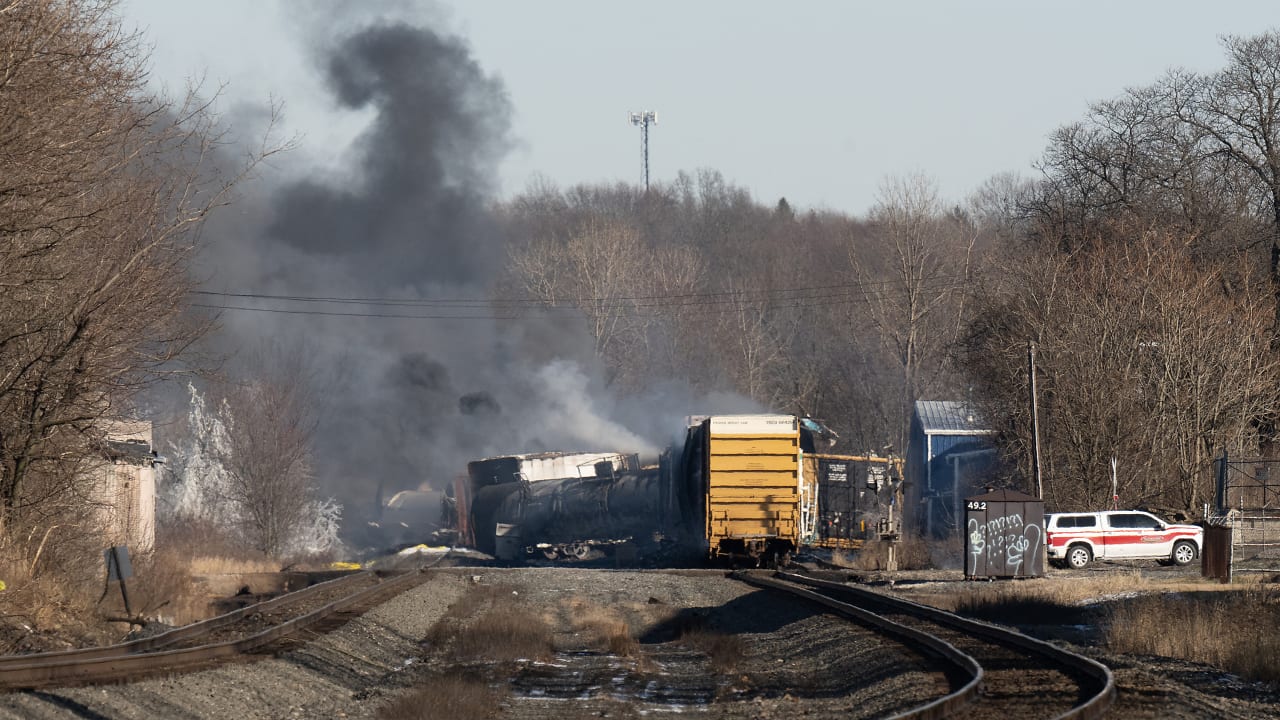Toxic Chemical Residue In Buildings Following Ohio Train Disaster

Table of Contents
Types of Toxic Chemicals Released and Their Persistence
The derailment released a cocktail of hazardous substances, including vinyl chloride, butyl acrylate, and ethylene glycol monobutyl ether. These chemicals pose significant threats due to their toxicity and persistence in the environment. Vinyl chloride, a known carcinogen, is volatile and readily enters the air, potentially causing long-term indoor air contamination. Butyl acrylate, a reactive chemical, can form persistent surface residues, leading to skin absorption and potential health problems. The persistence of these chemicals is further complicated by their interaction with various building materials. Porous materials like wood and drywall can absorb these chemicals, slowly releasing them over time, prolonging exposure.
- Vinyl chloride: High volatility leading to prolonged indoor air contamination; known carcinogen.
- Butyl acrylate: Potential for surface residue and skin absorption; irritant and potential sensitizer.
- Ethylene glycol monobutyl ether: Can cause respiratory irritation, headaches, and dizziness; may persist in soil and water.
- Impact of porous building materials: Absorption and slow release of chemicals, prolonging exposure.
Scientific studies on similar industrial accidents highlight the long-term presence of volatile organic compounds (VOCs) in buildings following chemical releases. Further research is crucial to fully understand the specific impact of this derailment's chemical mix on building materials and indoor air quality.
Pathways of Contamination into Buildings
The toxic chemicals released from the Ohio train derailment could have entered nearby buildings through several pathways. The initial release created a substantial plume that could have infiltrated structures through various routes. Air infiltration, a major concern, occurred through ventilation systems, windows, and gaps in building structures. Particulate matter containing these chemicals settled on surfaces—walls, floors, furniture—resulting in direct contact exposure.
- Air infiltration: Ventilation systems, open windows, and building gaps acted as entry points for airborne chemicals.
- Particulate matter deposition: Chemicals settled on surfaces, leading to direct contact and potential ingestion.
- Groundwater contamination: Leaching into groundwater could contaminate domestic water supplies used in buildings.
- Food and supply contamination: Chemicals could have contaminated food and supplies stored near the derailment site.
Wind direction and weather patterns played a significant role in spreading the contamination, influencing the concentration of toxic chemical residue in different areas. Areas downwind from the derailment site experienced higher levels of contamination.
Health Risks Associated with Toxic Chemical Residue
Exposure to the chemicals released in the Ohio derailment poses numerous and serious health risks, especially long-term consequences. Inhalation of airborne chemicals can cause respiratory problems, such as asthma and bronchitis. Dermal exposure to butyl acrylate can lead to skin irritation and allergic reactions. Moreover, some of these chemicals are suspected carcinogens, increasing the risk of various cancers. Neurological effects, reproductive issues, and other long-term health problems are also potential concerns.
- Respiratory problems: Asthma, bronchitis, and other respiratory illnesses due to inhalation of airborne chemicals.
- Neurological effects: Headaches, dizziness, impaired cognitive function, and other neurological symptoms.
- Cancer risks: Several of the released chemicals are known or suspected carcinogens.
- Reproductive issues: Potential impacts on fertility and reproductive health.
- Skin irritation and allergic reactions: Contact with surface residues can cause skin problems.
Long-term health monitoring of affected populations is crucial to assess the full extent of the health impacts and to guide appropriate medical interventions.
Assessment and Remediation Strategies for Toxic Chemical Residue
Assessing the extent of contamination in buildings requires a multi-faceted approach. Air quality testing and monitoring are essential to measure the levels of airborne chemicals. Surface wipe sampling and analysis are used to determine the presence and concentration of toxic chemical residue on various surfaces. These assessments guide remediation efforts, which may involve various decontamination procedures.
- Air quality testing and monitoring: Continuous monitoring to assess airborne chemical levels.
- Surface wipe sampling and analysis: Identifying and quantifying surface contamination.
- Decontamination procedures: Cleaning, specialized treatments, and possibly material removal.
- Building material replacement: In cases of severe contamination, replacement of affected materials may be necessary.
The challenges include the potential for persistent contamination within building materials and the difficulty in completely removing deeply absorbed chemicals. Complete remediation can be a lengthy and complex process.
Regulatory and Legal Implications of Toxic Chemical Residue
Regulatory agencies, such as the Environmental Protection Agency (EPA), play a crucial role in overseeing the cleanup and assessment process. They establish guidelines for remediation, monitor progress, and ensure compliance with environmental regulations. The legal implications are significant, with potential legal actions and liabilities for the responsible parties.
- Legal frameworks: Environmental laws govern cleanup, liability, and compensation.
- Compensation for residents: Legal actions may seek compensation for health issues and property damage.
- Long-term monitoring and enforcement: Ensuring long-term environmental safety and accountability.
The Ohio train derailment highlights the importance of robust regulatory frameworks and accountability mechanisms in preventing and mitigating the impacts of industrial accidents involving the release of toxic chemical residue.
Conclusion
The Ohio train derailment resulted in the significant release of toxic chemicals, posing substantial risks of lingering toxic chemical residue in nearby buildings. The potential health consequences are severe, necessitating thorough assessment, effective remediation, and robust regulatory oversight. Understanding the risks associated with toxic chemical residue and advocating for transparent investigation and remediation is crucial. Stay informed about ongoing developments and demand accountability from the responsible parties to ensure the health and safety of affected communities. Learn more about the long-term effects of toxic chemical residue and how you can protect yourself and your family.

Featured Posts
-
 Nfl Draft Scouting Raiders Spytek Evaluates Ashton Jeanty
Apr 25, 2025
Nfl Draft Scouting Raiders Spytek Evaluates Ashton Jeanty
Apr 25, 2025 -
 The Burden Of 2025 Michelle Obama And Taraji P Henson On Black Womens Mental Well Being
Apr 25, 2025
The Burden Of 2025 Michelle Obama And Taraji P Henson On Black Womens Mental Well Being
Apr 25, 2025 -
 Lockdowns Legacy A Look At North East Babies Born In 2020 2021
Apr 25, 2025
Lockdowns Legacy A Look At North East Babies Born In 2020 2021
Apr 25, 2025 -
 Pope Francis Funeral Public Viewing At St Peters Basilica
Apr 25, 2025
Pope Francis Funeral Public Viewing At St Peters Basilica
Apr 25, 2025 -
 Amrykh Ka Mwqf Dwnld Trmp Awr Ywkryn Pr Rwsy Hmlh
Apr 25, 2025
Amrykh Ka Mwqf Dwnld Trmp Awr Ywkryn Pr Rwsy Hmlh
Apr 25, 2025
Latest Posts
-
 Politicheskaya Izolyatsiya Zelenskogo Analiz Sobytiy 9 Maya
May 10, 2025
Politicheskaya Izolyatsiya Zelenskogo Analiz Sobytiy 9 Maya
May 10, 2025 -
 First Up Imf To Review Pakistans 1 3 Billion Loan Package And Other Top News
May 10, 2025
First Up Imf To Review Pakistans 1 3 Billion Loan Package And Other Top News
May 10, 2025 -
 Germaniya Ugroza Novogo Potoka Bezhentsev Iz Ukrainy Rol S Sh A
May 10, 2025
Germaniya Ugroza Novogo Potoka Bezhentsev Iz Ukrainy Rol S Sh A
May 10, 2025 -
 Den Pobedy Vladimir Zelenskiy Bez Podderzhki Soyuznikov
May 10, 2025
Den Pobedy Vladimir Zelenskiy Bez Podderzhki Soyuznikov
May 10, 2025 -
 Pakistan Economic Crisis Imfs 1 3 Billion Package Under Review
May 10, 2025
Pakistan Economic Crisis Imfs 1 3 Billion Package Under Review
May 10, 2025
